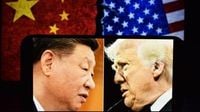September 2025 was a month of stark contrasts for the global electric vehicle (EV) industry, as China’s automakers continued their rapid expansion abroad while the United States faced mounting setbacks. According to the China Association of Automobile Manufacturers, China’s exports of “new energy vehicles”—a category that includes both battery electric vehicles and plug-in hybrids—doubled compared to the same period last year, reaching 222,000 units. This surge highlighted China’s growing dominance in the sector, even as its domestic market showed signs of cooling and international trade tensions escalated.
Global EV sales hit a record 2.1 million units in September, market research firm Rho Motion reported. Notably, China accounted for about two-thirds of these sales, underscoring its central role in the worldwide shift to electric mobility. The so-called “Golden September”—traditionally the peak sales season in China—saw carmakers launching an array of new models, aiming to capture both local and international demand. Yet, while China’s auto industry raced ahead, the U.S. EV sector found itself mired in crisis.
American manufacturers, once the giants of global car production, are now struggling to keep pace. The expiration of the U.S. electric vehicle tax credit two weeks before October 15, 2025, delivered a significant blow to the industry. The tax credit had been a lifeline for both consumers and manufacturers, helping to offset the high upfront costs of EVs. Its removal, part of the Trump administration’s One Big Beautiful Bill Act, left companies scrambling. As a result, General Motors reported a $1.6 billion hit to its quarterly earnings in October due to the declining value of its EV operations. Ford, meanwhile, announced a strategic shift away from fully electric models, with CEO Jim Farley indicating a new focus on partial electrification instead.
This policy reversal comes at a time when U.S. EVs remain significantly more expensive than their Chinese counterparts. BYD, one of China’s leading automakers, offers models starting at around $29,000, with some available for less than $8,000. These vehicles can charge in as little as five minutes, a major selling point for cost-conscious buyers. In contrast, Tesla’s most affordable models—stripped-down versions of the Model Y and Model 3—start at $36,990 and require 15 minutes to supercharge. Without the tax credit, these prices are even less competitive, especially when compared to the subsidies and incentives still available in Europe and China.
Europe, for its part, has emerged as another major driver of global EV growth. Sales on the continent hit new highs in September, buoyed by generous tax benefits and supportive policies. The United Kingdom, in particular, became the largest foreign market for BYD earlier in October, with the company’s sales there rocketing by 880% year-on-year. This remarkable growth made the UK BYD’s top market outside China, as reported by the Associated Press.
Chinese automakers have not confined their ambitions to Europe. Facing overcapacity and fierce price competition at home, they have increasingly turned to overseas markets, including Southeast Asia, the Middle East, and Africa. According to a recent report by the U.S.-based consultancy Rhodium Group, Chinese automakers invested more abroad than domestically last year—the first time this has happened since 2014. This outward push has been partly driven by international trade barriers, as the European Union, U.S., Canada, and others have imposed stiff tariffs on Chinese-made EVs.
While China’s EV exports surged, its domestic market showed mixed signals. Domestic passenger car sales climbed 11.2% year-on-year in September, a slowdown from August’s 15% rise. BYD’s domestic sales even fell by 5.5% compared to the same month last year, marking the company’s first decline since February 2024. This dip was attributed to intense competition and a crackdown on price wars among manufacturers, as well as the suspension of some local government subsidies for new energy vehicle trade-ins.
Subsidies have played a crucial role in shaping China’s EV market. For years, Beijing supported the industry with direct incentives and infrastructure investments, helping to make Chinese EVs both affordable and technologically advanced. However, as some local governments suspended trade-in subsidies in recent months, questions have arisen about the sustainability of domestic demand. Still, the export boom has more than compensated for any local softness, at least for now.
Meanwhile, the U.S. faces challenges that go beyond fiscal policy. The ongoing trade war with China has put additional strain on American EV manufacturers. China controls a staggering 70% of the world’s rare earth mineral mining and 90% of its refining capacity—resources that are essential for EV production. In the week before October 15, China tightened export controls on 12 out of 17 rare earth minerals, requiring foreign companies to obtain licenses for any product containing more than 0.1% China-sourced rare earths. Beijing also announced restrictions on lithium batteries, further complicating supply chains for U.S. automakers. In response, the Trump administration threatened to impose 100% tariffs on Chinese goods, escalating tensions even further.
Industry analysts warn that these developments could have long-term consequences. As Michael Dunne of Dunne Insights told Newsweek last month, “If the U.S. doesn’t transition to new energy vehicles quickly, Detroit will cede the global market and be reduced to a niche supplier of gas-powered pickup trucks and SUVs.” The implication is clear: without decisive action, the U.S. risks losing its historic leadership in the automotive industry.
Looking ahead, the global EV landscape appears increasingly divided. China’s manufacturers, flush with export success and technological prowess, are pressing their advantage in markets around the world. European automakers, backed by supportive governments, are also making significant strides. In contrast, the U.S. industry faces a combination of policy headwinds, supply chain vulnerabilities, and waning consumer incentives.
For now, September 2025 stands as a testament to both the promise and the peril of the electric vehicle revolution. As Chinese exports soar and American manufacturers regroup, the race for global EV supremacy shows no sign of slowing down—though the frontrunners may not be who they once were.




